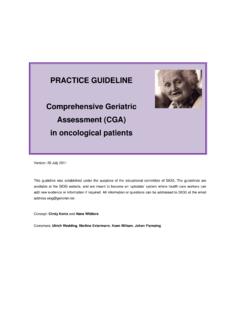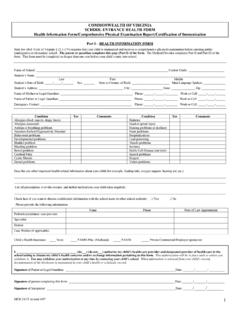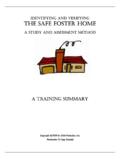Transcription of LOCUS - CT.GOV-Connecticut's Official State Website
1 LOCUS LEVEL OF CARE UTILIZATION SYSTEM FOR PSYCHIATRIC AND ADDICTION SERVICES Adult Version 2000 AMERICAN ASSOCIATION OF COMMUNITY PSYCHIATRISTS May 30, 2000 2000 American Association of Community Psychiatrists CONTENTS Introduction .. 2 Instructions .. 5 Evaluation Parameters for Assessment of Service Needs .. 6 Level of Care Definitions and Utilization Criteria .. 17 Appendix 1: Placement Flowchart .. 26 Appendix 2: Placement Grid .. 28 LOCUS Instrument 2000 1 INTRODUCTION TO ADULT VERSION 2000 With the arrival of managed care programs and principles in many areas of the country, the use of quantifiable measures to guide assessment.
2 Level of care placement decisions, continued stay criteria, and clinical outcomes is increasingly important. In the past there have been no widely accepted standards to meet these needs. The development of LOCUS has provided a specific instrument that can be used for these functions. It provides a common language and set of standards with which to make such judgements and recommendations. Clinicians now have an instrument, which is simple, easy to understand and use, but also meaningful and sufficiently sensitive to distinguish appropriate needs and services. It provides clear, reliable, and consistent measures that are succinct, but sufficient to make care or quality monitoring judgments. LOCUS has three main objectives.
3 The first is to propose a system for assessment of service needs for adult clients, based on six evaluation parameters. The second is to propose a continuum of service arrays which vary according to the amount and scope of resources available at each level of care in each of four categories of service. The third is to propose a methodology for quantifying the assessment of service needs to permit reliable determinations for placement in the service continuum. This document is a dynamic system, which has evolved over the past four years. Version 2000 makes some changes to address semantic concerns, but makes no changes in content from version , which was introduced in 1998. Preliminary reliability and validity testing have been encouraging, and additional data continues to be collected as this version is released.
4 The changes in 2000 will not affect those results; but will clarify some of the terminology previously used. The instrument has multiple potential uses: To assess immediate service needs ( , for clients in crisis) To plan resource needs over time, as in assessing service requirements for defined populations To monitor changes in status or placement at different points in time. As with previous versions, the current document is divided into three sections. The first section defines six evaluation parameters or dimensions: 1) Risk of Harm; 2) Functional Status; 3) Medical, Addictive and Psychiatric Co-Morbidity; 4) Recovery Environment; 5) Treatment and Recovery History; and 6) Engagement. A five-point scale is constructed for each dimension and the criteria for assigning a given rating or score in that dimension are elaborated.
5 In dimension IV, two subscales are defined, while all other dimensions contain only one scale. 2 LOCUS Instrument 2000 The second section of the document defines six levels of care in the service continuum in terms of four variables: 1) Care Environment, 2) Clinical Services, 3) Support Services, and 4) Crisis Resolution and Prevention Services. The term level is used for simplicity, but it is not our intention to imply that the service arrays are static or linear. Rather, each level describes a flexible or variable combination of specific service types and might more accurately be said to describe levels of resource intensity. The particulars of program development are left to providers to determine based on local circumstances and outcome evaluations.
6 Each level encompasses a multidimensional array of service intensities, combining crisis, supportive, clinical, and environmental interventions, which may vary independently. Patient placement criteria are then elaborated for each level of care. Separate admission, continuing stay, and discharge criteria are not needed in this system, as changes in level of care will follow from changes in ratings in any of the six parameters over the course of time. The final section describes a proposed scoring methodology that facilitates the translation of assessment results into placement or level of care determinations. Both a grid chart and a decision flow chart are provided for this purpose. We hope that this version of LOCUS will continue to stimulate considerable comment, discussion, and testing as reliability and validity studies continue.
7 It is recognized that a document of this type must be dynamic and that adjustments or addendums may be required either to accommodate local needs or to address unanticipated or unrecognized circumstances or deficiencies. The specific needs of special populations, such as children, adolescents, and the elderly will not be adequately addressed in this adult version. It does not claim to replace clinical judgment, and is meant to serve only as an operationalized guide to resource utilization that must be applied in conjunction with sound clinical thinking. It is offered as an instrument that should have considerable utility in its present form, but growth and improvement should be realized with time and further testing.
8 The AACP welcomes any comments or suggestions. Please send your comments to: Wesley Sowers, , Medical Director, Allegheny County Office of Behavioral Health, 304 Wood Street, 5th Floor, Pittsburgh, PA, 15222, Phone 412-350-3716, Fax 412-622-350-3880, email: LOCUS Instrument 2000 3 Acknowledgments This document was prepared by the American Association of Community Psychiatrists Health Care Systems Committee Task Force on Level of Care Determinations.
9 It was developed in cooperation with St. Francis Medical Center of Pittsburgh and the suggestions from multiple reviewers across the country. We would also like to acknowledge the intellectual stimulation provided by the review of multiple documents previously developed to address similar issues. Of particular influence in the conceptualization of LOCUS were the Patient Placement Criteria-1 of the American Society of Addiction Medicine, the Level of Care Assessment Tool of US Healthcare, and the Level of Need-Care Assessment (LONCA) Method. AACP Task Force on Level of Care Determinations Wesley Sowers, MD, Chairperson Cheryl S. Al-Mateen, MD Richard C. Lippincott, MD Donald B. Brown, MD Kenneth Minkoff, MD Gordon H.
10 Clark, Jr., MD David Moltz, MD Benjamin Crocker, MD Fred C, Osher, MD Robert M. Goisman, MD David A. Pollack, MD Steven Goldfinger, MD Andres Pumariega, MD Linda Goldwater Gochfeld, MD Michael A. Silver, MD Charles Huffine, MD Clifton R. Tennison, Jr., MD Margaret Kitchell, MD Kenneth Thompson, MD 4 LOCUS Instrument 2000 Level of Care Utilization System for Psychiatric and Addiction Services Instructions for Use Each evaluation parameter is defined along a scale of one to five.

















